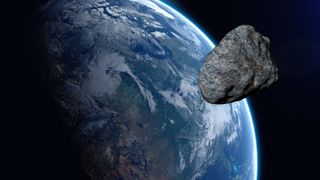A giant asteroid the size of a building just safely zoomed past Earth overnight
The building-sized asteroid came within 14 Earth-moon distances of our planet.

A building-sized asteroid whizzed by our planet overnight into Monday (May 9) and at a very safe distance, just like all the other giant space rocks we know of.
The asteroid, known officially as 467460 (2006 JF42), came within 14 Earth-moon distances of our planet, according to data from the Center for Near Earth Object Studies at NASA's Jet Propulsion Laboratory. In real terms, that's roughly 3.5 million miles (5.7 million kilometers) from our planet.
The flyby of the the asteroid (estimated at 1,247 feet to 2,822 feet across, or 380 to 860 meters) is a symbol of the ever-present change in our solar system. Our neighborhood is filled with asteroids and comets that are constantly moving around us. That said, NASA does keep a close eye on the ones that skirt our planet.
Its Planetary Defense Coordination Office monitors the sky with telescopes, and you can review prominent upcoming flybys and the agency's Small-Body Database to gain more information about space rocks.
Related: The greatest asteroid missions of all time!
While NASA does classify some asteroids as "potentially hazardous," that designation is not a cause for panic. The term arises from a complex calculation related to size (larger than 492 feet or 150 m) and the distance at which the object approaches Earth, among other factors.
There is no known threat to Earth despite decades of searching. While NASA has a curated list of asteroids it monitors due to a tiny and statistically improbable chance of impact, none of these are a pressing worry.
Get the Space.com Newsletter
Breaking space news, the latest updates on rocket launches, skywatching events and more!
That list is also updated from time to time, such as the removal of asteroid Apophis from the list in 2021 after fresh observations showed it poses no threat whatsoever to Earth in the next 100 years.
Scientists are becoming ever more adept at finding large asteroids like 2006 JF42 as telescope technology improves, which is why it may seem there are so many space rocks going by us these days. While NASA isn't worried about our current roster of asteroids, it does strategize defense technologies, just in case.
An example is the Double Asteroid Redirection Test (DART) mission that aims to smack a moonlet later this year to redirect its path around an asteroid, to demonstrate kinetic impacting technology against potential asteroid threats.
Follow Elizabeth Howell on Twitter @howellspace. Follow us on Twitter @Spacedotcom and on Facebook.
Join our Space Forums to keep talking space on the latest missions, night sky and more! And if you have a news tip, correction or comment, let us know at: community@space.com.

Elizabeth Howell (she/her), Ph.D., is a staff writer in the spaceflight channel since 2022 covering diversity, education and gaming as well. She was contributing writer for Space.com for 10 years before joining full-time. Elizabeth's reporting includes multiple exclusives with the White House and Office of the Vice-President of the United States, an exclusive conversation with aspiring space tourist (and NSYNC bassist) Lance Bass, speaking several times with the International Space Station, witnessing five human spaceflight launches on two continents, flying parabolic, working inside a spacesuit, and participating in a simulated Mars mission. Her latest book, "Why Am I Taller?", is co-written with astronaut Dave Williams. Elizabeth holds a Ph.D. and M.Sc. in Space Studies from the University of North Dakota, a Bachelor of Journalism from Canada's Carleton University and a Bachelor of History from Canada's Athabasca University. Elizabeth is also a post-secondary instructor in communications and science at several institutions since 2015; her experience includes developing and teaching an astronomy course at Canada's Algonquin College (with Indigenous content as well) to more than 1,000 students since 2020. Elizabeth first got interested in space after watching the movie Apollo 13 in 1996, and still wants to be an astronaut someday. Mastodon: https://qoto.org/@howellspace
